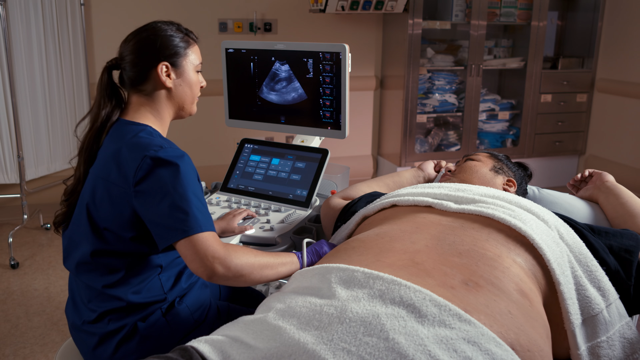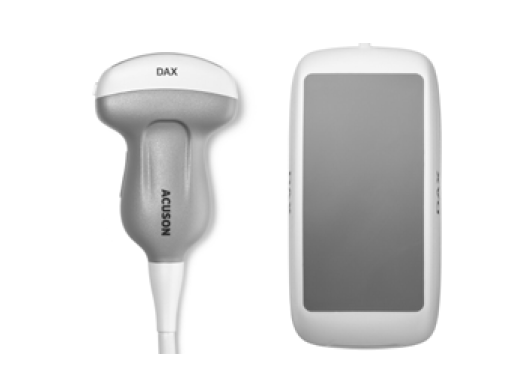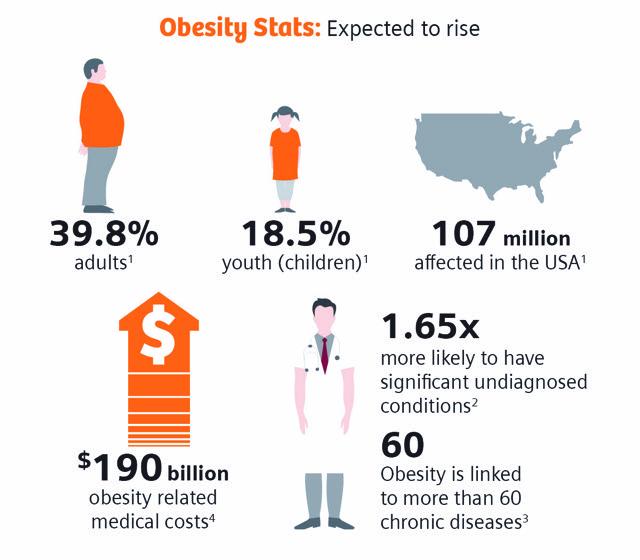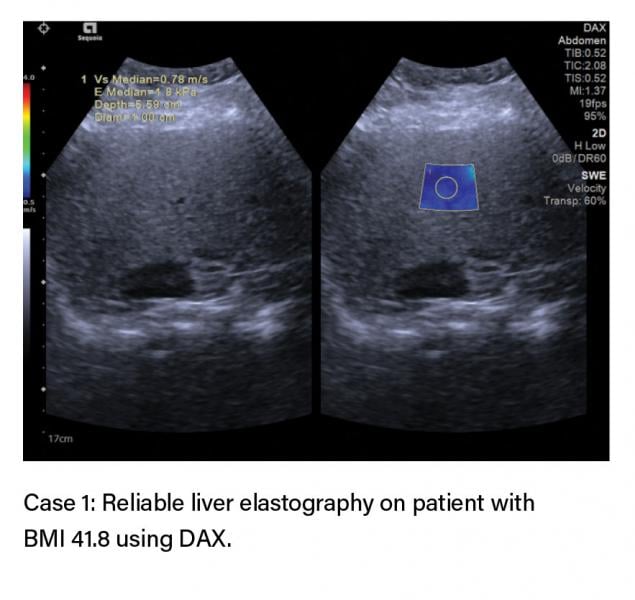
The Acuson Sequoia with Deep Abdominal Transducer (DAX) scanning a 600 pound patient.
“With our present technology, we often struggle with large patients,” said Richard G. Barr, M.D., Ph.D., at Southwoods Imaging. “With the new ACUSON Sequoia ultrasound system, we have the availability of the Deep Abdominal Transducer (DAX). This new technology allows us to get much deeper into the abdomen in those challenging patients. This is important because if we are looking for multiple lesions, we need to be able to scan the entire liver.” A radiologist for more than 25 years, Dr. Barr is president of Radiology Consultants, Inc. and a diagnostic radiology specialist at Southwoods Imaging, both in Youngstown, Ohio. With the new DAX technology, Dr. Barr can obtain diagnostic information on high BMI patients where traditional technology, such as B-mode, color, pulsed wave doppler, elastography and contrast enhanced ultrasound (CEUS) exams, fails.
The DAX transducer is available on the ACUSON Sequoia ultrasound system, which was designed with a new BioAcoustic Imaging architecture able to compensate for energy loss and adapt the signal to each patient’s bioacoustic characteristics. A unique and patented imaging transducer, the DAX leverages the power of BioAcoustic Imaging technology and penetrates up to 40 cm deep in the abdomen. DAX was also designed to work in advanced modes, including shear wave elastography, contrast enhanced ultrasound, and multimodality fusion imaging.
The Population Challenge
Obesity is a growing problem in the United States. In 2016 alone, obesity affected 107 million people in the country. Of those, 39.8 percent were adults and 18.5 percent were youth.1
For all patients, accurate and timely diagnosis is vital. Yet, a recent study found that obese patients are 1.65 times more likely to have significant undiagnosed conditions.2 With obesity linked to more than 60 chronic diseases and associated with almost 50 percent of all cancers in patients younger than 65, this is a critical population to address.3
At an estimated $190 billion, obesity-related medical costs are high.4 If the obesity incidence continues to increase, these costs will likely rise, particularly as the obese youth of today become the obese adults of tomorrow.
The Technical Challenge
In obese patients, it can be challenging to get reliable and diagnostic ultrasound images both from a technical aspect due to ultrasound physics, and ergonomically as the operator is often required to increase the pressure of the transducer on the body.
Due to the increased subcutaneous fat and adipose tissue, the ultrasound beam can be significantly attenuated due to ultrasound wave absorption and scattering that occurs with increasing depth.
The impact of obesity on image quality is highlighted in a 15-year longitudinal study.5 This study analyzed more than 5 million radiology reports and determined that abdominal ultrasonography was the modality most commonly associated with habitus-limited reports. “If a patient has a habitus-limited report on an abdominal ultrasound, it is likely that the next step would be additional imaging with CT or MRI … likely with contrast. If we could confidently answer those tough clinical questions right away in ultrasound, we could help to reduce these types of follow-up exams, associated costs, and unnecessary patient anxiety,” said Dr. Barr.
A Novel Approach
The Deep Abdominal Transducer (DAX) on the ACUSON Sequoia employs an advanced form of Multi-D beam formation that controls the beam thickness and beam formation, enabling unprecedented imaging throughout a 40 cm depth. This novel approach may allow the DAX to obtain clinically relevant information when conventional technology fails. “What we are finding is that the ACUSON Sequoia with DAX transducer is providing us with clinical advantages in a few specific areas compared to conventional technology. First, we are noticing that we are able to get color and Doppler information much deeper and easier in the abdomen, which is critical for evaluating abdominal vasculature. Second, we are also seeing increased penetration and improved accuracy and reliability in our liver elastography exams on high BMI patients when assessing chronic liver disease. Third, the DAX allows us to perform contrast enhanced
ultrasound exams much deeper with a high sensitivity for evaluating focal liver lesions. CEUS exams are traditionally limited in depth of penetration so this expands our clinical capabilities in CEUS,” said
Dr. Barr.
A New Level of Confidence
Case: 61 yo with BMI of 41.8, generalized abdominal pain
A 61-year-old female with a BMI of 41.8 (extremely obese) presented for an abdominal ultrasound with liver elastography for generalized abdominal pain and a history of non-alcoholic fatty liver disease (NAFLD).
To assess liver stiffness, an abdominal ultrasound with liver elastography was conducted on a conventional ultrasound system at the imaging center. Liver elastography shear waves are known to attenuate quickly; the attenuation increases with increased subcutaneous tissue. This makes obese patients a challenge for liver elastography exams. Most patient-related confounding factors increase the stiffness value; therefore, a normal value of elastography can be accepted as normal, whereas an increased value must be taken in clinical context.
When conducting the liver elastography exam on the conventional ultrasound system, there were some challenges in acquiring the elastography values due to drop out and limited areas of good quality in the acquisition. The shear wave values that were obtained were extremely elevated and consistent with that of a cirrhotic patient with a median stiffness of 2.05 m/s (13.05 kPa). The patient’s previous lab work and clinical history presented with a normal but fatty liver. For this patient, Dr. Barr brought in the ACUSON Sequoia with DAX to correlate the liver elastography results. Using the DAX, the values obtained were a median stiffness of 0.88 (2.35 kPa) indicating no clinically significant liver stiffness. The liver elastography results on the ACUSON Sequoia with DAX were consistent with the patient’s labs and other clinical considerations. For confirmation, a FibroSure blood test was performed, which came back as normal, confirming the data acquired with the DAX.
“Obesity is a patient factor known as a source of variability in liver elastography exams on conventional technology,” said Dr. Barr. “The pulse generating the shear wave attenuates as it traverses the patient and reaches a point where adequate shear waves are not generated for accurate measurements on conventional technology. What we experienced on this patient was that the ACUSON Sequoia with DAX was able to provide quick, accurate, and reliable elastography measurements even in an extremely obese patient. Now she can continue her routine yearly follow-up for NAFLD.”
Case: 87 yo male with BMI of 27, abdominal pain/liver function tests
An 87-year-old male with a BMI of 27 (overweight) came in for an abdominal ultrasound for abdominal pain and increased liver function tests. The patient stated that he was told over 25 years ago that he had a liver infection but hasn’t had any additional follow-up. No previous imaging was conducted.
Performed on a conventional ultrasound system, the ultrasound exam demonstrated multiple liver masses as well as a potential portal vein thrombosis. As the exam was technically challenging and required sensitive color Doppler at depth, the ACUSON Sequoia with DAX was brought in for additional
patient assessment.
“The portal vein was relatively deep, and we wanted to see if the DAX could provide any additional useful information. Since the DAX can penetrate much deeper in CEUS mode, we decided to inject ultrasound contrast agents to confirm a portal vein thrombosis,” said Dr. Barr. Upon injection of the ultrasound contrast agents, the main portal vein demonstrated arterial flow. Typical presentation of non-malignant portal vein thrombosis on CEUS is no arterial flow is seen. Further analysis on the ACUSON Sequoia using Pulsed Wave Doppler confirmed pulsatile flow not seen on the conventional ultrasound system. The pulsatile flow within the main portal vein is an indication of tumor in the vessel. The diagnosis for this patient was advanced hepatocellular carcinoma (HCC) with tumor in vessel. Due to several factors, including tumor in vessel, this patient is not a candidate for liver transplant.
“With deeper penetration in CEUS and the deep Doppler capabilities of the DAX, we were able to make a confident diagnosis and distinguish between portal vein thrombosis and portal vein tumor thrombosis, which is a critical finding for transplant candidates, as it precludes transplantation,” said Dr. Barr.
Conclusion
As precision medicine expands and the delivery of healthcare evolves, there is a need for specialized technology that addresses all patient variations and body types. The increased incidence of obesity makes imaging the high-BMI patient a critical population to address with ultrasound.
However, obesity is shown to have a negative impact on image quality. As patients get larger, the number of inconclusive results proportionally increases. Ultrasound is the modality most highly impacted by this trend. The new ACUSON Sequoia was designed to address many of the key challenges in ultrasound, which includes obtaining high-quality, reliable images on the high-BMI patient in an ergonomic and economic way. “On the ACUSON Sequoia and with DAX technology, I feel confident when scanning patients ranging from the pediatric patient, all the way to the bariatric patient,” said Dr. Barr.
Case study supplied by Siemens Healthineers.
References:
1. Adult Obesity Facts [Internet]. Centers for Disease Control and Prevention; 2018 Aug [cited 2019 May]. Available from: https://www.cdc.gov/obesity/data/adult.html.
2. “Fat-shaming” Patients Can Cause Real Harm [Internet]. WebMD, HealthDay Reporter; 2017 Aug [cited 2019 May]. Available from: https://www.webmd.com/diet/obesity/news/20170803/fat-shaming-patients-can-cause-real-harm.
3. Execessive Weight Gain, Obesity, and Cancer. Opportunities for Clinical Intervention [Internet]. JAMA; 2017 Nov 28 [cited 2019 May]. Available from: https://jamanetwork.com/journals/jama/article-abstract/2656710.
4. Economic Costs [Internet]. Harvard T.N. Chan, Obesity Prevention Source; 2019 [cited 2019 May]. Available from: https://www.hsph.harvard.edu/obesity-prevention-source/obesity-consequences/economic/
5. Uppot R, Sahani D, Hahn P, Kalra M, Saini S, Mueller P. Effect of obesity on image quality: fifteen-year longitudinal study for evaluation of dictated radiology reports. Radiological Society of North America. Radiology. 2006 Aug; 240(2): 435-9.







 December 23, 2025
December 23, 2025 









